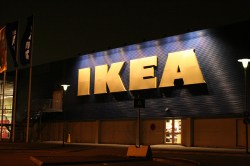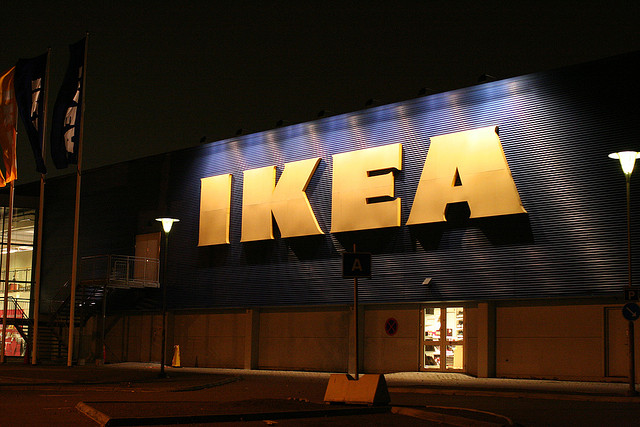
Photo by yassan-yukky.
Most Americans wouldn’t consider eating a burger made of chopped-up, unidentified meat that could include, say, monkey or mountain lion. But dorm rooms, group houses, and respectable living rooms across the country are furnished with the wood-based equivalent of mystery meat: dirt-cheap dressers, desks, tables, and cabinets made from chopped-up wood of indeterminate, and potentially troubling, origin.
Particleboard might not be as physically off-putting as pink slime, but the source of its contents can be as hard to trace as the source of an E. coli outbreak. And while the materials in an Ikea dresser won’t make consumers physically sick, the purchaser of these products might well feel queasy. Right now, there’s no way of knowing whether or not that chest of drawers or flimsy bookshelf contains wood from old-growth or illegally logged forests — in other words, whether the product is implicated in deforestation, climate change, and drug smuggling.
Congress is about to make it even less likely that Ikea and similar companies will provide that information. In 2008, lawmakers put into place new measures that would have required retailers to disclose the source of wood in their products. Even before the new law was passed, Ikea and other retailers were fighting it, and already, the government has given them a grace period in which they do not have to provide details on the makeup of materials like particleboard. Now, House leaders are pushing through a bill that could let companies like Ikea continue to hide where much of the wood they use comes from.
The Lacey Act, the law that’s at risk, first passed Congress in 1900, when hunters were pushing the passenger pigeon towards extinction and populations of birds sporting desirable plumage were dwindling. One of the country’s oldest conservation laws, the act aimed to limit poaching and the interstate sale of illegally killed wildlife. Over the next century, Congress expanded the law to cover amphibians, mollusks, crustaceans, reptiles, and indigenous plants.
The latest round of amendments — the ones now at issue — targeted illegally logged wood, not just in the United States but abroad as well. Under the law as it stands now, it’s illegal to import plants or plant products that were harvested in violation of foreign laws meant to protect plants and forests. (In the most high-profile enforcement case so far, the federal government raided Gibson Guitar, galvanizing Republicans against the new law.) And anyone importing a plant product — most anything made out of wood counts — has to declare to the border service what type of plants were used to make it and what country they came from.

Photo by David Pettersson.
Compared to companies like Walmart and Target, Ikea has been a leader in responsible sourcing of wood, but even before Congress passed those amendments in 2008, Ikea was fighting to limit their scope. The company’s representatives argued that lawmakers were asking Ikea and companies like it to provide too much information, and that to comply with the law would raise their costs and, therefore, the prices they’d have to charge their customers. “The cost of almost any finished wooden consumer good would skyrocket,” Christopher Smith, an Ikea compliance specialist, warned in comments the company submitted.
In particular, Ikea was worried about sharing information about the wood sources for its products made with “composite materials.” A catchall term for particleboard, fiberboard, and other boards made from sawdust and wood scraps, “composite materials” are one reason so much of Ikea’s furniture is so cheap. (They’re also the reason why even the scrawniest of undergrads can lift a six-and-a-half foot Ikea bookcase with one hand.) In the 2011 financial year [PDF], almost three-fifths of the wood Ikea used went to making “board material,” as opposed to solid wood.
Ikea argues that it’s next to impossible to track where the wood that goes into making these products comes from. If a product had “very ‘neat’ sourcing” — in which each material came from just one contracted supplier, and each sub-supplier had a maximum of one sub-supplier — a relatively simple piece of furniture, like the MALM dresser, might contain 26 different species of wood from 18 countries, Ikea says [PDF].
More likely, though, the sourcing is not neat. According to Ikea, suppliers often source from three to four sub-suppliers. Each sub-supplier might source from a handful of board mills. Each board mill works with multiple sawmills — five or more, in some cases. The sawmills buy their lumber from dozens of logging companies. In the end, a simple piece of furniture could require about 800 different producers.
Because tracking the source of wood through these production chains is so complicated, retailers shouldn’t be required to declare the source of that wood until “it is feasible, practical and effective to gather such information,” Ikea’s Laurie Everill told Congress in May [PDF]. “However, we would like to underline that this should not in any way reduce the responsibility of the importer to exercise due care in procurement,” she said. In other words, keeping track of wood sourcing is hard, but consumers should trust that Ikea and similar companies will make sure the wood comes from the right places.
This argument would be more convincing if illegal logging weren’t so widespread and devilishly hard to root out. Ikea pledged in 1991 [PDF] to use only responsibly grown tropical wood and put in a set of minimum requirements — no illegally harvested wood, no wood from protected forest areas — for its solid wood, veneer, and plywood in 2000.
And yet a Washington Post investigation, published in 2007, called out Ikea specifically for its connections to illegal logging near the China-Russia border. “They never send people to supervise the purchasing … basically they just let us pick what wood we want,” one supplier told the Post. Ikea itself admits [PDF] that “our global sourcing means that we source wood also from regions that are troubled by illegal logging and other unsustainable forestry practices. Our suppliers in these areas struggle with low availability of certified wood volumes and traceability in complex supply chains.”
Even logging practices that fit within Ikea’s requirements can be unsavory. A recent investigation by the environmental group Protect the Forest connected Ikea to logging old-growth forests in Karelia, a region of northwestern Russia where forests have high conservation value — exactly the type of wood Ikea says will not pass even its minimum standards for use. The company’s logging there doesn’t violate Russian law. “But this says more about the lack of strength in the Russian forest legislation than it does on the ambitions of Ikea’s forestry,” says Linda Ellegaard Nordström, a Protect the Forest board member.
Ikea does track the supply chains for its wood products — just internally. Grist asked the company what a “feasible, practical and effective” system to track wood sources for composite materials would look like and how it would differ from the company’s internal tracking system; Ikea chose not to answer those questions.
If the company gets its way, it won’t have to answer questions about the contents of many of its wood products for the foreseeable future. Earlier in June, a House committee passed a bill that would remove reporting requirements for composite materials from the Lacey Act. House Majority Leader Eric Cantor has promised a vote on the measure in July. Rumblings of dissatisfaction in the Senate also worry Lacey Act supporters. While we may not be eating mystery meat, there’s a good chance we’ll be eating at tables made of mystery wood for a long time to come.



